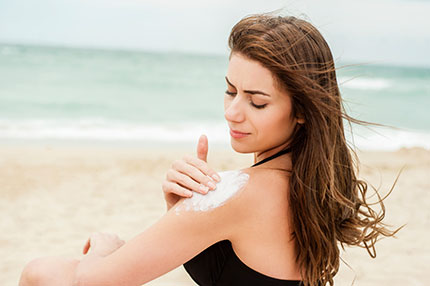Summer's Coming: Sunscreens 101

With the outdoor temperatures rising, soon summer will be here, which means it's time to store away those baggy sweat pants and sweaters that cover your body all winter and pull out the more revealing summer attire. This is also the time of year when many women are looking for sunscreens to protect their skin against the harmful effects of the sun. But not all sunscreens are created equal as some provide higher levels of protection than others.
With so many choices in sunscreen products, it can be very tricky to know how to best protect your face & body from the harmful effects of the sun. Here is an overview of what every woman should know about sunscreens including how to choose the right one.
What Are Sunscreens Designed to Protect Us From?
Ultraviolet or UV rays are part of the light spectrum that is emitted from the sun. Two types of UV rays, A and B, have long enough wavelengths to penetrate the Earth's atmosphere. UV A rays have the longest wavelengths, which can penetrate deeply into the skin. These rays, which are always present year-round, can age and wrinkle unprotected skin. UV B rays are those that turn the skin a red color when sunburned. How many UV B rays you're exposed to is dependent on the time of the day and where you're located on Earth. In the United States, we get the most UV B rays from April through October during the daytime hours of 10am and 4pm.
Numerous studies tell us that both UV A and UV B rays cause skin cancers including the deadliest form, called melanoma. The FDA states that a sunscreen must provide protection against both UVA and UVB rays in order to be labeled as a “broad spectrum” sunscreen.
How to Choose a Sunscreen
Sunscreens come with a sun protection factor (SPF). This tells you how long you can be exposed to sunlight without burning and the higher the SPF the longer you can be exposed without reapplying. One thing that many people do not realize is that SPF only refers to protection against UV B rays and not UV A rays. This is why it's important to choose a sunscreen that's labeled “broad spectrum” to ensure it provides protection against both UV A and UV B rays. And as far as the SPF number goes, dermatologists recommend using a sunscreen with a SPF factor of 30, which blocks 97% of the sun's rays.
To ensure that your skin is protected when out in the sun, use a water-resistant, broad spectrum sunscreen with a SPF of no lower than 30 and reapply it every two hours for maximum protection.
*In addition to being labeled as “broad spectrum,” sunscreens with both UV A and UV B protection can also be marked as “multi-spectrum” or “UVA/UVB protection.”
Because no sunscreen provides full protection from the sun, experts recommend that in addition to using a good quality sunscreen that everyone should seek shade, wear protective clothing & sunglasses and stay away from tanning beds which are all important in reducing the risk of developing skin cancer.
High SPFs Lead to A False Sense of Security
Many studies have shown that sunscreens with SPF ratings of over 50 do not provide any added benefits or protection. Products with very high SPFs can give people a false sense of security wherein they do things such as stay in the sun for extended periods of time, avoid seeking shade and neglecting to wear sun-protective clothing. This is why the FDA is working on putting a cap on the SPF of sunscreens at 50+.
To stay healthy when getting bikini-ready for summer, don't forget to take good care of your skin and apply a liberal amount of sunscreen before heading outdoors! Just follow the guidelines above and choose a good quality sunscreen that is designed for your skin type to ensure you're doing all you can to protect your skin and yourself! The team at Doylestown Women's Health Center wish all of our patients a fun, safe and happy summer!